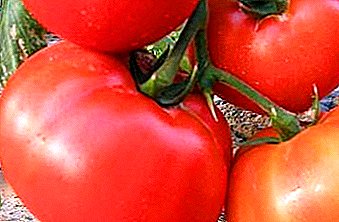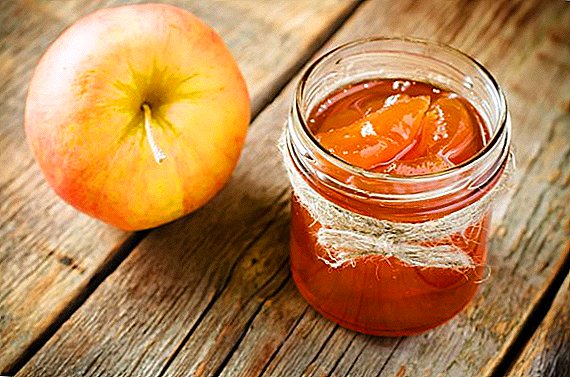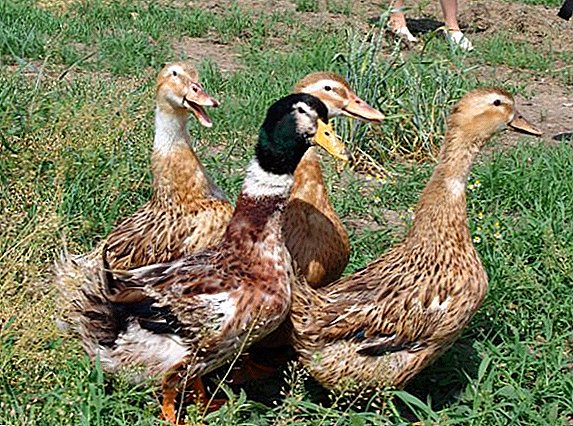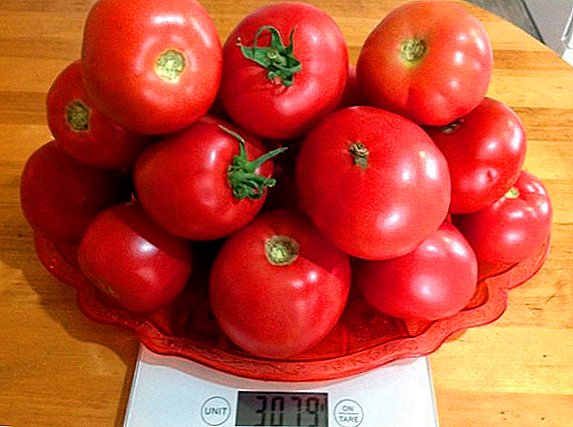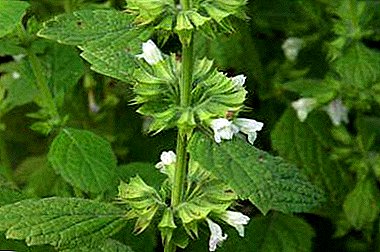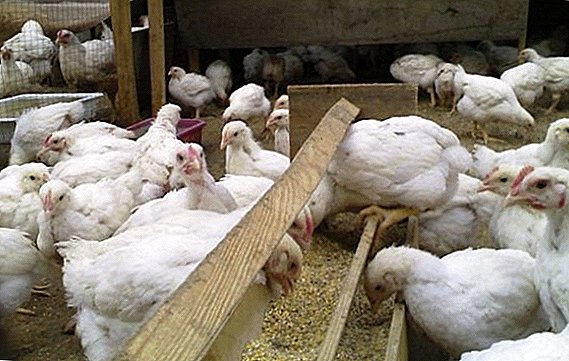 Novice poultry farmers are often interested in the question of whether it is necessary to use animal feed for domestic breeding of poultry and whether it is possible to do without it. Perhaps there are some nuances in use that can reduce its consumption. About what this product is, what is its use and why it is needed - in our article.
Novice poultry farmers are often interested in the question of whether it is necessary to use animal feed for domestic breeding of poultry and whether it is possible to do without it. Perhaps there are some nuances in use that can reduce its consumption. About what this product is, what is its use and why it is needed - in our article.
What is feed
Compound feed is a granulated feed mixture, produced industrially at the enterprise of the corresponding profile. In the event that the feed mixture is also produced industrially, it is no different from the feed, it is one and the same product with different names.  If the feed mixture was produced by an artisanal method, in a private farm, possibly according to an original recipe, then it is impossible to call it mixed fodder.
If the feed mixture was produced by an artisanal method, in a private farm, possibly according to an original recipe, then it is impossible to call it mixed fodder. Important! The use of feed allows in the shortest possible time to grow a broiler weighing 2.4-2.6 kg. This can be done within 6-7 weeks, it is not economically profitable to feed the bird anymore, it will gain a lot of weight.
Types and composition of feed
Compound feeds are divided into:
- "Starter", PC 5;
- "Growth";
- "Finish", PK 6.
Some manufacturers produce pre-launch mixes. From the names it becomes clear that these feeds are intended for different periods of the life of broilers.
It is useful to learn how to properly feed broiler chickens and whether it is possible to add nettles to their diet.
"Start" for chickens
"Start", or PC 5 - feed intended for feeding chickens from the first hours of life up to 14-15 or up to 30-31 days, depending on the feeding pattern. This feed is produced in the form of small granules.  The composition of the mixture "Start" should correspond approximately to the following characteristics:
The composition of the mixture "Start" should correspond approximately to the following characteristics:
- corn - 36%;
- wheat - 21%;
- soy meal - 30%;
- rapeseed oil and oilcake - 5.5%;
- molasses and corn gluten - 2.5%.
Read more about broiler feeds: PC 5 and PC 6.
"Growth" for young
This composition is used for feeding young animals at the age of 3-4 weeks of life. The main purpose - the rapid growth and stable weight gain feathered. The rate of such feed - 85-115 g daily, which must be divided into 3 meals. The composition may vary in percentage terms, but its basis is as follows:
- cereals;
- makukh of sunflower and soy;
- yeast;
- flour from fish and meat;
- calcium carbonate;
- phosphates;
- amino acids and enzymes.
 With proper feeding, depending on the food scheme chosen, the bird gains up to 50 g of weight every day. Feed the bird 3-4 times a day.
With proper feeding, depending on the food scheme chosen, the bird gains up to 50 g of weight every day. Feed the bird 3-4 times a day.
Did you know? After 5 weeks of feeding broiler feed, their weight is more than 2 kg. At the same time per 1 kg of weight gain takes an average of 1.65 kg of feed mixture.
"Finish" for fattening adult broilers
This feed is formed into rather large granules, intended for feeding adult broilers, starting from one month to slaughter. Under other relevant circumstances, fattening broiler finishing feed contributes to a set of weight - up to 1 kg in 20 days.  The composition of high-quality finishing feed should look like this:
The composition of high-quality finishing feed should look like this:
- wheat - 45%;
- corn - 24%;
- Soybean meal - 16%;
- sunflower cake - 5%;
- fish meal - 6%;
- sunflower oil - 3%;
- limestone flour, salt, vitamins and minerals - 1%.
Find out what the rules of weight gain broilers.
How to choose a quality feed
When choosing a food for birds, pay attention to such nuances:
- First of all, inspect the feed visually: the granules should not crumble, the presence of large amounts of dust in the bags indicates a low quality of the product, it may have been stored in inappropriate conditions and dried up.
- Too saturated green color indicates a large amount of grass or green flour, before buying such feed, consider whether to overpay for grass that you can prepare yourself in the summer.
- Examine the composition of the product: fermented milk products that are sources of essential proteins may be present in the starting mixtures; the presence of flour from bones and meat, lysine and vegetable oil is desirable in the composition of the growth mixture.
- The main difference in the composition of mixtures for different ages is the amount of protein. As is known, this substance is the main building material of any living organism, therefore at the initial stage it is necessary a lot, then the amount of protein is reduced, for greater energy intensity of the product emphasis is placed on carbohydrates.
- Unscrupulous manufacturers may not write about this, but still note whether there are antibiotics in the composition. It seems that everyone understands the inadmissibility of their wide, and often, unreasonable use.
How to give: the scheme and norms of feeding broilers feed
There are several different broiler feeding schemes. Almost all of them include starting and finishing feed mixtures. If the power scheme is limited to only these two types of feed, it is called a two-stage. This is the most commonly used broiler feeding scheme. Each poultry farmer decides on what type of feeding him to stop.
This is the most commonly used broiler feeding scheme. Each poultry farmer decides on what type of feeding him to stop.
Important! With any feeding scheme, it is worth remembering about the need for a sufficient amount of fresh water from birds. The ratio of the volume of water consumed by the broilers to the feed should be approximately as follows: for 2 parts of feed - 3.5 parts of water.
Two stage
This broiler feeding scheme includes the following phases:
- I phase - starter feed from 1 to 30 days;
- Phase II - finishing feed from 31 days before slaughter.
Three stage
 This scheme includes, in addition to the starting and finishing types of the mixture, also growth:
This scheme includes, in addition to the starting and finishing types of the mixture, also growth:
- Phase I - starting (from 1 to 15 days);
- Phase II - finishing (from 15 days to 30);
- Phase III - finishing (from 31 days to slaughter).
Four-stage
There is another four-phase model. The scheme looks like this:
- Phase I - Pre-Start (from 1 to 5 days);
- Phase II - start (from 6 to 18 days);
- Phase III - growth (from 19 to 37 days);
- Phase IV - finish (from 38 days to slaughter).
- from 1 to 5 days - 15-20 g;
- from 6 to 18 days - 20-90 g;
- from 19 to 37 days - 90-140 g;
- from 38 days to slaughter - 140-170 g.
Did you know? Broiler chickens began to breed in the USA in the 30s of the XX century by crossing roosters Cornish and chickens Plymouth Rock. This branch of the poultry industry reached its peak by the 60s of the twentieth century.Regardless of which scheme you chose, the number of meals also matters:
- 1-7 days - 8 times a day;
- 8-14 day - 6 times;
- 15-21 days - 4 times;
- from day 22 until slaughter - 2 times a day.
Pros and cons of the use of feed
From the advantages of feeding with fodder mixtures of industrial production it is possible to distinguish the following:
- grain feeding does not give the feathery essential amino acids and proteins, in contrast to the use of combined feed mixtures;
- compound feeds contribute to a very fast weight gain, which is impossible to achieve when feeding on cereals and pasture.
 Some negative points in the application of feed:
Some negative points in the application of feed:
- the use of industrial feed mixtures is much more expensive than grain feeding;
- feeding with extruded mixtures should be carried out in strict control of the volume of liquid consumed by the bird;
- it is believed that when fed with mixed fodder meat is obtained of lower quality, less natural than with traditional cereal.
Familiarize yourself with the instructions for making feeders for chickens and adult broilers.
Whether to use a combined industrial feed for breeding poultry is up to you. It should be borne in mind that if you breed chicken breeds of chickens for sale, mixed feed justifies itself, besides, do not forget that you can reduce its cost by acquiring a granulator and a grain crusher. In the same case, if in your small private ownership there are several laying hens and you breed them for personal consumption, it is quite possible to do with grain and pasture.


